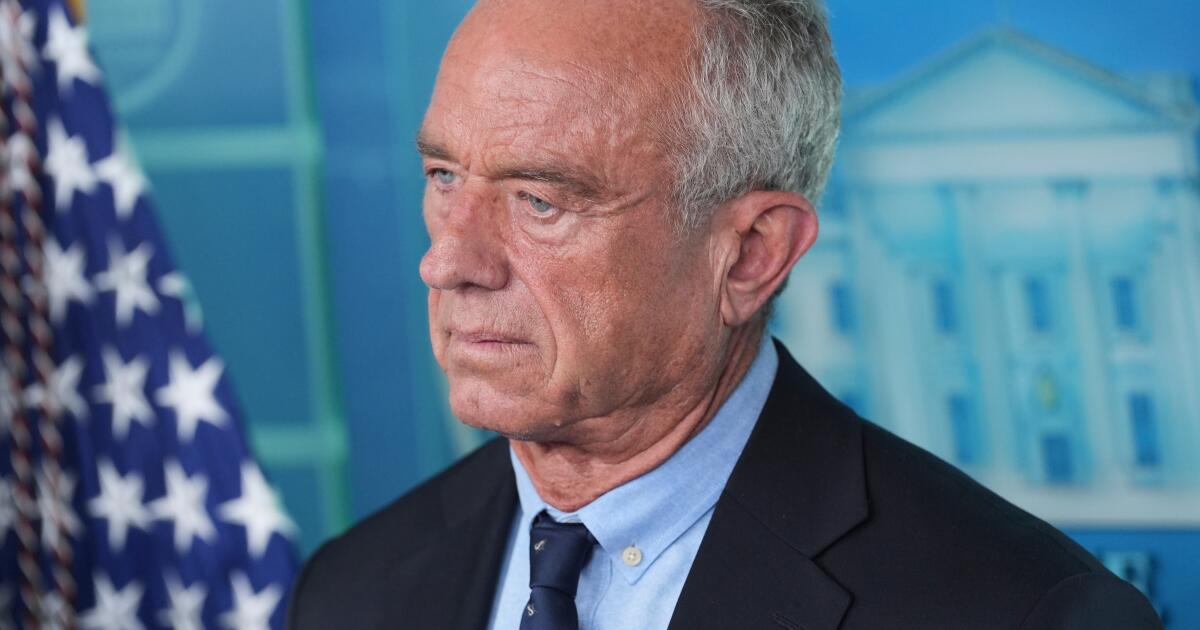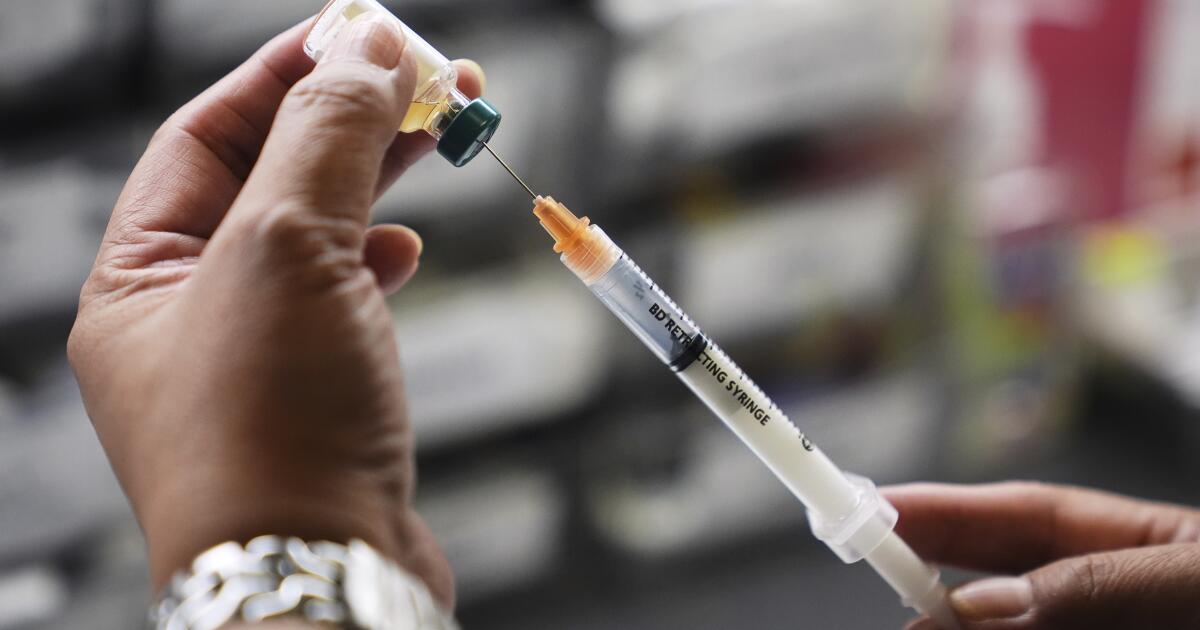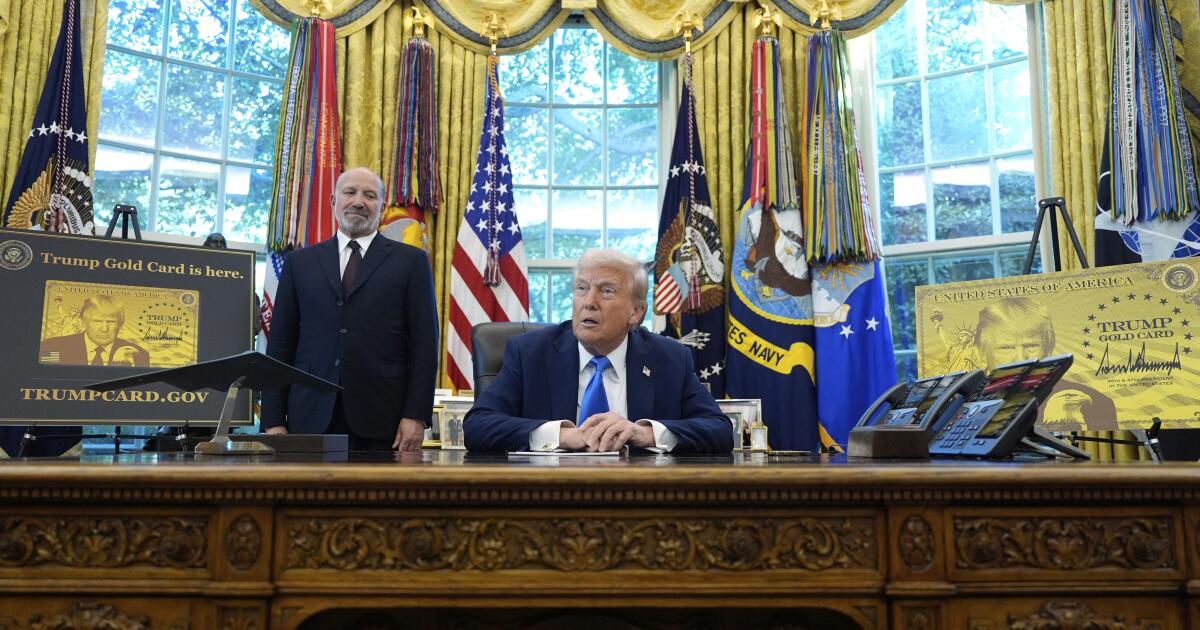Science
Thousand Oaks nursing home resident arrested on suspicion of killing his roommate

A resident of a Thousand Oaks nursing home has been arrested on suspicion of killing his roommate, the Ventura County Sheriff’s Office said.
Deputies responded at 4:40 a.m. Friday to a call from the Silverado memory care facility on Warwick Avenue about a resident who was agitated and had broken a window, according to a Sheriff’s Department news release.
The deputies found the resident Thomas Buckley, 58, in a common area of the facility and detained him, authorities said. The nursing home’s staff then checked on his roommate, Michael Patterson, 72. The workers found that Patterson had severe injuries, which appeared to be caused by an assault.
Paramedics were called to the scene and Patterson was pronounced dead a short time later, authorities said.
Investigators said that before deputies arrived, Buckley had assaulted one of the facility’s workers, causing minor injuries.
Patterson’s death is being investigated as a homicide. The Ventura County Medical Examiner’s Office will conduct an autopsy to determine the official cause and manner of death.
Buckley was booked on suspicion of murder, assault with a deadly weapon and vandalism, the Sheriff’s Department said. He remains in custody and his bail was set at $2 million. His arraignment hearing is scheduled for Tuesday at 1:30 p.m. in Ventura County Superior Court.
Anyone with information regarding this incident should contact Det. Gerardo Cruz at (805) 384-4726 or Det. Erik Hernandez at (805) 384-4729.

Science
Trump administration declares ‘war on sugar’ in overhaul of food guidelines

The Trump administration announced a major overhaul of American nutrition guidelines Wednesday, replacing the old, carbohydrate-heavy food pyramid with one that prioritizes protein, healthy fats and whole grains.
“Our government declares war on added sugar,” Health and Human Services Secretary Robert F. Kennedy Jr. said in a White House press conference announcing the changes. “We are ending the war on saturated fats.”
“If a foreign adversary sought to destroy the health of our children, to cripple our economy, to weaken our national security, there would be no better strategy than to addict us to ultra-processed foods,” Kennedy said.
Improving U.S. eating habits and the availability of nutritious foods is an issue with broad bipartisan support, and has been a long-standing goal of Kennedy’s Make America Healthy Again movement.
During the press conference, he acknowledged both the American Medical Association and the American Assn. of Pediatrics for partnering on the new guidelines — two organizations that earlier this week condemned the administration’s decision to slash the number of diseases that U.S. children are vaccinated against.
“The American Medical Association applauds the administration’s new Dietary Guidelines for spotlighting the highly processed foods, sugar-sweetened beverages, and excess sodium that fuel heart disease, diabetes, obesity, and other chronic illnesses,” AMA president Bobby Mukkamala said in a statement.
Science
Contributor: With high deductibles, even the insured are functionally uninsured

I recently saw a patient complaining of shortness of breath and a persistent cough. Worried he was developing pneumonia, I ordered a chest X-ray — a standard diagnostic tool. He refused. He hadn’t met his $3,000 deductible yet, and so his insurance would have required him to pay much or all of the cost for that scan. He assured me he would call if he got worse.
For him, the X-ray wasn’t a medical necessity, but it would have been a financial shock he couldn’t absorb. He chose to gamble on a cough, and five days later, he lost — ending up in the ICU with bilateral pneumonia. He survived, but the cost of his “savings” was a nearly fatal hospital stay and a bill that will quite likely bankrupt him. He is lucky he won’t be one of the 55,000 Americans to die from pneumonia each year.
As a physician associate in primary care, I serve as a frontline witness to this failure of the American approach to insurance. Medical professionals are taught that the barrier to health is biology: bacteria, viruses, genetics. But increasingly, the barrier is a policy framework that pressures insured Americans to gamble with their lives. High-deductible health plans seem affordable because their monthly premiums are lower than other plans’, but they create perverse incentives by discouraging patients from seeking and accepting diagnostics and treatments — sometimes turning minor, treatable issues into expensive, life-threatening emergencies. My patient’s gamble with his lungs is a microcosm of the much larger gamble we are taking with the American public.
The economic theory underpinning these high deductibles is known as “skin in the game.” The idea is that if patients are responsible for the first few thousand dollars of their care, they will become savvy consumers, shopping around for the best value and driving down healthcare costs.
But this logic collapses in the exam room. Healthcare is not a consumer good like a television or a used car. My patient was not in a position to “shop around” for a cheaper X-ray, nor was he qualified to determine if his cough was benign or deadly. The “skin in the game” theory assumes a level of medical literacy and market transparency that simply doesn’t exist in a moment of crisis. You can compare the specs of two SUVs; you cannot “shop around” for a life-saving diagnostic while gasping for air.
A 2025 poll from the Kaiser Family Foundation points to this reality, finding that up to 38% of insured American adults say they skipped or postponed necessary healthcare or medications in the past 12 months because of cost. In the same poll, 42% of those who skipped care admitted their health problem worsened as a result.
This self-inflicted public health crisis is set to deteriorate further. The Congressional Budget Office estimates roughly 15 million people will lose health coverage and become uninsured by 2034 because of Medicaid and Affordable Care Act marketplace cuts. That is without mentioning the millions more who will see their monthly premiums more than double if premium tax credits are allowed to expire. If that happens, not only will millions become uninsured but also millions more will downgrade to “bronze” plans with huge deductibles just to keep their premiums affordable. We are about to flood the system with “insured but functionally uninsured” patients.
I see the human cost of this “functional uninsurance” every week. These are patients who technically have coverage but are terrified to use it because their deductibles are so large they may exceed the individuals’ available cash or credit — or even their net worth. This creates a dangerous paradox: Americans are paying hundreds of dollars a month for a card in their wallet they cannot afford to use. They skip the annual physical, ignore the suspicious mole and ration their insulin — all while technically insured. By the time they arrive at my clinic, their disease has often progressed to a catastrophic event, from what could have been a cheap fix.
Federal spending on healthcare should not be considered charity; it is an investment in our collective future. We cannot expect our children to reach their full potential or our workforce to remain productive if basic healthcare needs are treated as a luxury. Inaction by Congress and the current administration to solve this crisis is legislative malpractice.
In medicine, we are trained to treat the underlying disease, not just the symptoms. The skipped visits and ignored prescriptions are merely symptoms; the disease is a policy framework that views healthcare as a commodity rather than a fundamental necessity. If we allow these cuts to proceed, we are ensuring that the American workforce becomes sicker, our hospitals more overwhelmed and our economy less resilient. We are walking willingly into a public health crisis that is entirely preventable.
Joseph Pollino is a primary care physician associate in Nevada.
Insights
L.A. Times Insights delivers AI-generated analysis on Voices content to offer all points of view. Insights does not appear on any news articles.
Viewpoint
Perspectives
The following AI-generated content is powered by Perplexity. The Los Angeles Times editorial staff does not create or edit the content.
Ideas expressed in the piece
-
High-deductible health plans create a barrier to necessary medical care, with patients avoiding diagnostics and treatments due to out-of-pocket cost concerns[1]. Research shows that 38% of insured American adults skipped or postponed necessary healthcare or medications in the past 12 months because of cost, with 42% reporting their health worsened as a result[1].
-
The economic theory of “skin in the game”—which assumes patients will shop around for better healthcare values if they have financial responsibility—fails in medical practice because patients lack the medical literacy to make informed decisions in moments of crisis and cannot realistically compare pricing for emergency or diagnostic services[1].
-
Rising deductibles are pushing enrollees toward bronze plans with deductibles averaging $7,476 in 2026, up from the average silver plan deductible of $5,304[1][4]. In California’s Covered California program, bronze plan enrollment has surged to more than one-third of new enrollees in 2026, compared to typically one in five[1].
-
Expiring federal premium tax credits will more than double out-of-pocket premiums for ACA marketplace enrollees in 2026, creating an expected 75% increase in average out-of-pocket premium payments[5]. This will force millions to either drop coverage or downgrade to bronze plans with massive deductibles, creating a population of “insured but functionally uninsured” people[1].
-
High-deductible plans pose particular dangers for patients with chronic conditions, with studies showing adults with diabetes involuntarily switched to high-deductible plans face 11% higher risk of hospitalization for heart attacks, 15% higher risk for strokes, and more than double the likelihood of blindness or end-stage kidney disease[4].
Different views on the topic
-
Expanding access to health savings accounts paired with bronze and catastrophic plans offers tax advantages that allow higher-income individuals to set aside tax-deductible contributions for qualified medical expenses, potentially offsetting higher out-of-pocket costs through strategic planning[3].
-
Employers and insurers emphasize that offering multiple plan options with varying deductibles and premiums enables employees to select plans matching their individual needs and healthcare usage patterns, allowing those who rarely use healthcare to save money through lower premiums[2]. Large employers increasingly offer three or more medical plan choices, with the expectation that employees choosing the right plan can unlock savings[2].
-
The expansion of catastrophic plans with streamlined enrollment processes and automatic display on HealthCare.gov is intended to make affordable coverage more accessible for certain income groups, particularly those above 400% of federal poverty level who lose subsidies[3].
-
Rising healthcare costs, including specialty drugs and new high-cost cell and gene therapies, are significant drivers requiring premium increases regardless of plan design[5]. Some insurers are managing affordability by discontinuing costly coverage—such as GLP-1 weight-loss medications—to reduce premium rate increases for broader plan members[5].
Science
Trump administration slashes number of diseases U.S. children will be regularly vaccinated against

The U.S. Department of Health and Human Services announced sweeping changes to the pediatric vaccine schedule on Monday, sharply cutting the number of diseases U.S. children will be regularly immunized against.
Under the new guidelines, the U.S. still recommends that all children be vaccinated against measles, mumps, rubella, polio, pertussis, tetanus, diphtheria, Haemophilus influenzae type B (Hib), pneumococcal disease, human papillomavirus (HPV) and varicella, better known as chickenpox.
Vaccines for all other diseases will now fall into one of two categories: recommended only for specific high-risk groups, or available through “shared clinical decision-making” — the administration’s preferred term for “optional.”
These include immunizations for hepatitis A and B, rotavirus, respiratory syncytial virus (RSV), bacterial meningitis, influenza and COVID-19. All these shots were previously recommended for all children.
Insurance companies will still be required to fully cover all childhood vaccines on the CDC schedule, including those now designated as optional, according to the Department of Health and Human Services.
Health Secretary Robert F. Kennedy Jr., a longtime vaccine critic, said in a statement that the new schedule “protects children, respects families, and rebuilds trust in public health.”
But pediatricians and public health officials widely condemned the shift, saying that it would lead to more uncertainty for patients and a resurgence of diseases that had been under control.
“The decision to weaken the childhood immunization schedule is misguided and dangerous,” said Dr. René Bravo, a pediatrician and president of the California Medical Assn. “Today’s decision undermines decades of evidence-based public health policy and sends a deeply confusing message to families at a time when vaccine confidence is already under strain.”
The American Academy of Pediatrics condemned the changes as “dangerous and unnecessary,” and said that it will continue to publish its own schedule of recommended immunizations. In September, California, Oregon, Washington and Hawaii announced that those four states would follow an independent immunization schedule based on recommendations from the AAP and other medical groups.
The federal changes have been anticipated since December, when President Trump signed a presidential memorandum directing the health department to update the pediatric vaccine schedule “to align with such scientific evidence and best practices from peer, developed countries.”
The new U.S. vaccination guidelines are much closer to those of Denmark, which routinely vaccinates its children against only 10 diseases.
As doctors and public health experts have pointed out, Denmark also has a robust system of government-funded universal healthcare, a smaller and more homogenous population, and a different disease burden.
“The vaccines that are recommended in any particular country reflect the diseases that are prevalent in that country,” said Dr. Kelly Gebo, dean of the Milken Institute School of Public Health at George Washington University. “Just because one country has a vaccine schedule that is perfectly reasonable for that country, it may not be at all reasonable” elsewhere.
Almost every pregnant woman in Denmark is screened for hepatitis B, for example. In the U.S., less than 85% of pregnant women are screened for the disease.
Instead, the U.S. has relied on universal vaccination to protect children whose mothers don’t receive adequate care during pregnancy. Hepatitis B has been nearly eliminated in the U.S. since the vaccine was introduced in 1991. Last month, a panel of Kennedy appointees voted to drop the CDC’s decades-old recommendation that all newborns be vaccinated against the disease at birth.
“Viruses and bacteria that were under control are being set free on our most vulnerable,” said Dr. James Alwine, a virologist and member of the nonprofit advocacy group Defend Public Health. “It may take one or two years for the tragic consequences to become clear, but this is like asking farmers in North Dakota to grow pineapples. It won’t work and can’t end well.”
-

 World1 week ago
World1 week agoHamas builds new terror regime in Gaza, recruiting teens amid problematic election
-

 News1 week ago
News1 week agoFor those who help the poor, 2025 goes down as a year of chaos
-

 Science1 week ago
Science1 week agoWe Asked for Environmental Fixes in Your State. You Sent In Thousands.
-

 Business1 week ago
Business1 week agoA tale of two Ralphs — Lauren and the supermarket — shows the reality of a K-shaped economy
-

 Detroit, MI4 days ago
Detroit, MI4 days ago2 hospitalized after shooting on Lodge Freeway in Detroit
-

 Politics1 week ago
Politics1 week agoCommentary: America tried something new in 2025. It’s not going well
-

 Politics1 week ago
Politics1 week agoMarjorie Taylor Greene criticizes Trump’s meetings with Zelenskyy, Netanyahu: ‘Can we just do America?’
-

 Health1 week ago
Health1 week agoRecord-breaking flu numbers reported in New York state, sparking warnings from officials














